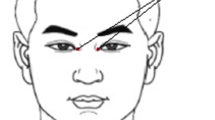Abstract
Objective
To observe the clinical efficacy of combining two needling manipulations, Er Long Xi Zhu (two dragons playing with a pearl) and Guo Yan Re (heat produced to reach the eyes), in treating dry eye syndrome (DES) of lung-yin deficiency pattern.
Methods
Fifty-six eligible DES patients of lung-yin deficiency were randomized into an observation group and a control group, with 28 cases in each group. Same acupoints were selected in the two groups: Cuanzhu (BL 2), Sizhukong (TE 23), Taiyang (EX-HN 5) and Fengchi (GB 20) were chosen as the major points and Feishu (BL 13) and Chize (LU 5) as the adjuvant. Er Long Xi Zhu and Guo Yan Re needling manipulations were applied in the observation group while twirling reinforcing manipulation was used in the control group. Treatment was conducted once per day in both groups, for two sets of 15 consecutive days at a 2-day interval. Changes in the symptom score, tear break-up time (BUT) and tear production were observed afterwards, and the clinical efficacy was also compared between the two groups.
Results
The total effective rate was 92.8% in the observation group, higher than 71.4% in the control group, and the between-group difference was statistically significant (P<0.05). After treatment, the symptom score, tear BUT and tear production showed significant improvements in both groups (all P<0.05); the symptom score, BUT and tear production in the observation group were significantly different from those in the control group (all P<0.05).
Conclusion
Given the same acupoint selection, combining Er Long Xi Zhu and Guo Yan Re needling manipulations can produce more significant clinical efficacy than twirling reinforcing manipulation in treating DES of lung-yin deficiency pattern.
【摘要】
目的
观察“二龙戏珠”结合“过眼热”针法治疗肺阴不足型干眼症的临床疗效。
方法
将符合入组标准 的56例肺阴不足型干眼症患者随机分成观察组和对照组, 每组28例。两组取穴相同, 主穴取攒竹、丝竹空、太阳和 风池, 配穴取肺俞和尺泽。观察组采用“二龙戏珠”加“过眼热”针法, 对照组采用捻转补法。两组均每日治疗1次, 连续治疗15 d后休息2 d, 再治疗15 d后观察两组症状评分、泪膜破裂时间和泪液分泌量的变化, 并比较两组临床疗 效。
结果
观察组总有效率为92.8%, 高于对照组的71.4%, 组间差异具有统计学意义(P<0.05)。治疗后, 两组症状评 分、泪膜破裂时间和泪液分泌量均较治疗前显著改善(均P<0.05); 观察组症状评分、泪膜破裂时间和泪液分泌量均 与对照组有统计学差异(均P<0.05)。
结论
取穴相同的情况下, “二龙戏珠”结合“过眼热”针法治疗肺阴不足型 干眼症的临床疗效优于捻转补法。
Similar content being viewed by others
References
Nelson JD, Craig JP, Akpek EK, Azar DT, Belmonte C, Bron AJ, Clayton JA, Dogru M, Dua HS, Foulks GN, Gomes JAP, Hammitt KM, Holopainen J, Jones L, Joo CK, Liu Z, Nichols JJ, Nichols KK, Novack GD, Sangwan V, Stapleton F, Tomlinson A, Tsubota K, Willcox MDP, Wolffsohn JS, Sullivan DA. TFOS DEWS II introduction. Ocul Surf, 2017, 15(3): 269–275.
Keratopathy Group, Chinese Ophthalmological Society, Chinese Medical Association. Expert consensus on clinical diagnosis and treatment of dry eye (2013). Zhonghua Yanke Zazhi, 2013, 49(1): 73–75.
Liu W. Reflection on dry eye in Chinese medicine. Zhongguo Zhongyi Yanke Zazhi, 2013, 23(4): 304–305.
State Administration of Traditional Chinese Medicine. Criteria of Diagnosis and Therapeutic Effects of Diseases and Syndromes in Traditional Chinese Medicine. Nanjing: Nanjing University Press, 1994: 75.
Fang XL. Traditional Acupuncture Manipulation Therapeutics. Lanzhou: Lanzhou University Press, 2014.
Zheng KS. Complete Collection of Zheng’s Acupuncture-moxibustion. Beijing: People’s Medical Publishing House, 2017: 292.
Dong GR, Ma TM. Techniques of Acupuncture and Moxibustion. Beijing: China Press of Traditional Chinese Medicine, 2012: 43.
Ministry of Health of the People’s Republic of China. Guiding Principles for Clinical Study of New Chinese Medicines. Beijing: China Medical Science Press, 2002: 233–234.
Peng S. Clinical Observation of Oral Administration of Run Mu Sheng Jin Decoction Plus Fumigation for Dry Eye Syndrome of Lung-yin Deficiency Pattern. Changsha: Master Thesis of Hunan University of Chinese Medicine, 2019.
Zhang XY, Ma LG. Spiritual Pivot, Yellow Emperor’s Classic of Internal Medicine. Chengdu: Sichuan Publishing House of Science & Technology, 2008: 542.
Liu JW, Zhao YD, Zhu L, Han C. Research progress on etiology and pathogenesis of xeroma. Zhongyiyao Xuebao, 2019, 47(6): 121–124.
Ma XJ, Zhao YD, Zhang GX, Zhao CZ. The rules of acupoint selection of acupuncture for dry eye. Zhongguo Zhen Jiu, 2019, 39(1): 87–90.
Shen XY. Science of Meridians and Acupoints. Beijing: China Press of Traditional Chinese Medicine, 2016.
Wei XR, Yue ZH, Wei GW, Chen XL, Liu L, Xue ZH. Advance of clinical studies on Sancai acupoint method. Zhenjiu Linchuang Zazhi, 2015, 31(8): 78–80.
Zhao YD, Han DY. Clinical observation of Erlong Xizhu acupuncture for retinitis pigmentosa. Zhongguo Zhen Jiu, 2015, 35(7): 681–684.
Qiao X, Du XZ, Liu X, Wang YX, Zhang FF, Zhang TZ, Li XL. Zheng’ Guo-Yan-Re needling technique for diabetic fundus hemorrhage. Zhongguo Zhen Jiu, 2019, 39(8): 849–852.
Ren LF. Efficacy of acupuncture plus visual function training for low myopia and its improving effect on ocular accommodation. Shanghai Zhenjiu Zazhi, 2019, 38(8): 888–891.
Wang DY, Yang HY, Dong X, Song J, He L. Progress and comments on the study of acupuncture dose-effect relationship. Zhonghua Zhongyiyao Zazhi, 2019, 34(11): 5014–5017.
Lou S, Jiang Y, Li AL, Fu HP, Li Y. Clinical study of periocular acupuncture in the treatment of dry eye. Zhongguo Zhongyiyao Xiandai Yuancheng Jiaoyu, 2018, 16(21): 136–138.
Ma HJ, Zheng YL, Li YY. New experimental research progress on prevention and treatment of traditional Chinese medicine in xerophthalmia in recent five years. Zhonghua Zhongyiyao Zazhi, 2018, 33(10): 4563–4567.
Acknowledgments
This work was supported by Project of Zheng’s Acupuncture Manipulation Academic School Heritage Studio, Gansu Province 甘肃郑氏针法学术流派传承工 作室建设项目, No. 9983999957).
Author information
Authors and Affiliations
Corresponding author
Additional information
Conflict of Interest
The authors declare that there is no potential conflict of interest in this article.
Statement of Informed Consent
Informed consent was obtained from all individual participants.
Rights and permissions
About this article
Cite this article
Jing-wen, L., Yao-dong, Z., Ling, Z. et al. Efficacy observation of acupuncture for dry eye syndrome of lung-yin deficiency pattern. J. Acupunct. Tuina. Sci. 19, 72–77 (2021). https://doi.org/10.1007/s11726-021-1228-x
Received:
Accepted:
Published:
Issue Date:
DOI: https://doi.org/10.1007/s11726-021-1228-x
Keywords
- Acupuncture Therapy
- Acupuncture Reinforcing Method
- Tear Break-up Time
- Tear Secretion
- Lung-yin Deficiency
- Dry Eye Syndrome



